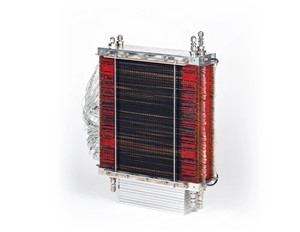ZeroAvia High Temperature Fuel Cell Testing Shows Large Aircraft and Rotorcraft Potential for Hydrogen-Electric Propulsion
March 10, 2023
-ZeroAvia today announced that it has achieved record-breaking performance in testing of its High Temperature Proton Exchange Membrane (HTPEM) systems. Early testing of the pressurized 20kW HTPEM stack power module in ZeroAvia’s UK R&D location has demonstrated a record 2.5 kW/kg specific power at the cell level, paving the way for 3+ kW/kg system level densities in the next 24 months.
Developing fuel cell technology for aviation is critical to enable true zero-emission commercial flight, and for energy intensive applications - like large fixed wing aircraft and rotorcraft - it is necessary to increase the temperature and pressure within fuel cell stacks in order to have a commercially viable product. Increased temperature and pressure allows for air cooling, reduces cooling drag, simplifies the system, and ultimately enables much more demanding applications.
ZeroAvia’s team has made unprecedented deep tech breakthroughs by delivering a pressurized HTPEM system, innovative conductive coatings enabling the use of aluminum bipolar plates in highly aggressive HTPEM environments, and a novel approach to advanced membrane electrode assembly (MEA).
ZeroAvia’s proprietary technology has been developed over the last three years as part of a concentrated effort to build an in-house portfolio of critical technologies for fuel cell aviation at ZeroAvia. Further R&D will deliver over 3kW/kg fuel cell system specific power, which enables a step change in performance relative to the traditional fuel cell technologies, making fuel cell propulsion commercially viable for large aircraft. Specifically, the HTPEM systems will be prime candidates to support ZeroAvia’s ZA2000 powertrain for 40-80 seat aircraft, as well as a range of rotorcraft and eVTOL applications. This next generation of fuel cells could also be sufficient to enable electric propulsion systems for 100+ seat single-aisle turbofan aircraft such as the Boeing 737 and Airbus A320.
The components used in the ZeroAvia system have already been validated through third-party independent testing at several independent labs, including a leading U.S. Department of Energy national lab. The testing confirms the potential for HTPEM systems to accelerate the development of large hydrogen-electric powertrains for large aircraft.
ZeroAvia’s recent breakthrough first flight of a 19-seat aircraft utilized Low Temperature PEM (LTPEM) fuel cell systems. Today’s LTPEM systems work well for the sub-megawatt scale of these smaller aircraft, but the lower stack core temperatures make it harder to remove heat from the larger systems. HTPEM technology eliminates a number of components from the fuel cell system and reduces cooling drag, thereby enabling commercially relevant payload and range. ZeroAvia’s HTPEM can also offer greater durability, further reducing operating costs for airlines.
Val Miftakhov, CEO and founder of ZeroAvia, said:
“The companies and geographies that seize the lead in high fuel cell temperatures and pressures will lead the industry. This progression is similar to the story of turbine engines, where ever-increasing temperatures and pressures drove higher and higher performance. Hydrogen fuel cell propulsion is the most environmental and economical alternative to existing engines, and HTPEM is the most promising route to delivering these benefits into large aircraft categories. I am confident that what we are demonstrating now is the core building block to delivering zero-emission flight for all categories of aircraft in the long-term.”
Interest in hydrogen aviation has grown considerably in recent months. Hydrogen combustion engines are being developed to remove carbon emissions from flight, but they face the steep environmental penalty of maintaining or increasing the non-CO2 emissions impacts of aviation on the climate. These non-CO2 impacts are thought to have twice the climate impact of carbon emissions alone, according to a report from EASA. Additionally, a non-combustion, hydrogen-electric approach eliminates extreme material stresses inherent in modern combustion engines, which dramatically reduces maintenance costs, further improving the economics of the hydrogen-electric propulsion.
ZeroAvia’s development of the HTPEM systems is in part supported by the HyFlyer II project, backed by the UK Government via the Aerospace Technology Institute (ATI).
Source : ZeroAvia


